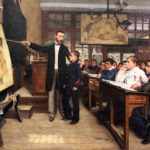Summarizing the latest round of complaints about higher education in The New York Review of Books, Peter Brooks describes an “indiscriminate flailing about in criticism of the university, some of it justified, much of it misdirected, and some pernicious.” Certain authors appear to be shocked that education doesn’t automatically make one a moral person. Others are bewildered that the effects of a liberal arts degree can’t be quantified like in any other industry, as if students were products on an assembly line. Indeed, in the last half-decade, observers of American academia have identified two equally lamentable pitfalls: expecting too much from a university education, and not expecting enough.
Stanley Fish (Save the World on Your Own Time, 2008) chastised modern professors for attempting a “character transplant” in students who had “signed on for something more modest, to wit, a course of instruction.” Charles Murray (Real Education, 2008) made similar points, rebuking the impossibly high ideals of what he called “educational romanticism.” Alongside these critiques, however, came publications that mourn higher education’s failure to address the bigger, interdisciplinary questions. These include recent books by Anthony Kronman (Education’s End, 2007), Martha Nussbaum (Not for Profit, 2010), and Mark C. Taylor (Crisis on Campus, 2010). Kronman, to choose just one example, laments, “I have watched the question of life’s meaning lose its status as a subject of organized academic instruction and seen it pushed to the margins of professional respectability in the humanities, where it once occupied a central and honored place.”
But while critiques of both romanticism and shortsightedness need to be made, rarely do commentators on higher education appear to grasp the full contour of what has been lost. It remains strange that universities, inhabited by a disproportionate number of historians, usually limit themselves to seriously investigating the last century or so when diagnosing their malaise. Medieval wisdom on education can provide some missing perspective, regarding both what learning is and the setting in which it best occurs.
Augustine wrote De Magistro, a dialogue in the form of a conversation between him and his son, in the late fourth century. De Magistro is a surprising treatise. For starters, we find a fourth-century thinker accurately diagnosing the modern/postmodern trajectory that has paralyzed so many educators today:
Start your day with Public Discourse
Sign up and get our daily essays sent straight to your inbox.For just as it is proper to assent to things well explored and perused, so it is perilous to consider things known which are not known. Because there is a danger, when those things are often upset which we supposed would stand firmly and endure, lest we fall into such distrust and hatred of reason that it might seem that confidence in evident truth itself is not warranted.
Following modernity’s epistemic avarice, contemporary thought has indeed fallen, at points, into a “distrust and hatred of reason.” But Augustine not only diagnoses this intellectual condition, he provides a way forward as well.
One reason educational romanticism has had such a grip in American schooling is that it contains an element of truth. Indeed, student-centered, “you can do it” approaches have some value, and Augustine agrees. “Who is so stupidly curious,” he asks, “as to send his son to school in order that he may learn what the teacher thinks?”
Those who are called pupils consider within themselves whether what has been explained has been said truly… Thus they learn, and when the interior truth makes known to them that true things have been said, they applaud, but without knowing that instead of applauding teachers they are applauding learners.
The difference between Augustine and educational romanticism, however, is that the “inner oracle” for Augustine is not the latent power of the unaided student. Instead, this power comes from God: “He who is said to reside in the interior man is Christ, that is, the unchangeable excellence of God and His everlasting wisdom, which every rational soul does indeed consult.” While unquestionably Christian, Augustine’s view is not strictly sectarian—he refers to every rational soul. Augustine combines skepticism in the power of mere words with confidence in a power higher than any human teacher.
Nearly a millennium later, in a treatise also entitled De Magistro, Thomas Aquinas concretized Augustine’s teaching philosophy with two illustrations. First, Aquinas uses a horticultural analogy to caution against Augustine’s Platonism. “Knowledge does preexist in the student,” Aquinas admits, though “not completely but in a seminal state.” Aquinas broadens the role of a good teacher, who is actively to foster an environment where such “seeds” of knowledge can grow: “Now while it is true that no created power has implanted these knowledge ‘seeds’ in us, still the action of a created power [i.e., a teacher] can realize the potential of those seeds.”
Aquinas’ second analogy is a medical one. A physician, according to Aquinas, cannot heal the body. Instead, a physician creates the stimulants and conditions for the body’s healing itself. In the same way, the teacher cannot inspire, illuminate, or impart genuine knowledge—but diligent teachers can greatly improve the conditions for such illumination. For Aquinas, the teacher plays a somewhat larger role within Augustine’s nearly mystical view of student-centered learning.
But it is one thing to expound upon the mystery of learning, and another to discuss the practical conditions necessary for such learning to occur. It is here that ancient and contemporary educational practices may seem most disparate. In an essay titled “Alexandria: A School for Training in Virtue,” Robert Louis Wilken relates that the first-century teacher Apollonius of Tyana gave up on lecturing to large audiences, insisting, “No discourse can be really useful, unless it is delivered to a single individual.” Plutarch agreed, adding, “Admonitions to specific persons produce the most useful fruit.”
The Catechetical school of Alexandria, which drew on Apollonius and Plutarch, understood this well. Learning had to be intimate, because only in this way could a “character transplant” (so distasteful to Stanley Fish) occur. In The Tutor, for example, Clement of Alexandria argued that the role of the teacher was to better students’ souls, not just their minds. Intellectual training certainly followed, but the Alexandrians understood that if knowledge were not planted in the seedbed of wisdom, it would either never take root, or—far worse—grow into something dangerous. From Alexandria we learn that ethics was never a sub-discipline of the educational curriculum, but was, in a way, its entirety.
What’s more, the primary medium for such instruction was not a course, but friendship. Origen, Alexandria’s greatest teacher, understood friendship to be that “affable and affectionate disposition which is shown in the [teacher’s] words and his associations.” A chief metaphor used by Origen’s students to describe their teacher’s legendary effectiveness was the friendship of David and Jonathan described in the Bible. That very scene holds an honored place in the finest visual manifesto for liberal arts renewal that I am aware of—the window scheme of the Princeton University Chapel.
A nineteenth-century master of this pedagogical ideal of friendship was John Henry Newman, who lived it for two decades as a tutor at Oriel College, where the University of Oxford contracted to a human scale. Christopher Olaf Blum’s essay “Newman’s Collegiate Ideal” explains that Newman’s focus on friendship enabled the university to be “not a chance collection of individuals building their careers, but a kind of fellowship, even a friendship, whose characteristic activity was to ‘rejoice in the truth’ (gaudium de veritate).” Common meals were the soil where acquaintanceship grew into friendship, which Aristotle understood to be among the highest of life’s rewards. Genuine learning without the “pure and clear atmosphere of thought” fostered by true friendship was difficult to achieve. Like Origen, Newman understood that “personal influence… was the means of propagating the truth.”
In an age of unmanageable class sizes and overworked (and out of work) professors, advocating such an intimate scale of virtue-based learning may seem naive. Yet such ideals are probably closer to most of our own learning histories than we might think. If a given class distilled more than mere information, but instead shaped our lives and futures, some kind of friendship probably played a role. Wherever our own education occurred, or is occurring, transformative learning continues to happen as it always has—through communities of friendships upheld by some measure of mutual virtue. Even within oversized, impersonal institutions, such communities tend to arise spontaneously.
The bloated modern educational system may be due for collapse. But so far as I am aware, there is no university where the mystery of learning as described by Augustine and Aquinas has been successfully prohibited, or where the Alexandrian ideal of communities of virtue seeking truth through friendships has been effectively proscribed. Whether in the form of a well-managed classroom, a religious fellowship, an Honors College, or one of the university’s increasing numbers of satellite institutions, communities of renewal in higher education have either recovered these principles, or never lost them in the first place. We can wait for massive reform to fix our troubled universities, or we can continue practicing such ideals wherever we are today. That may be the only way to bring about any broader solution.














